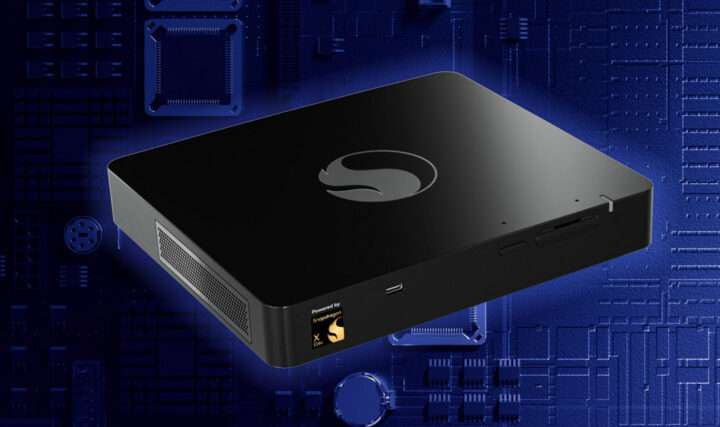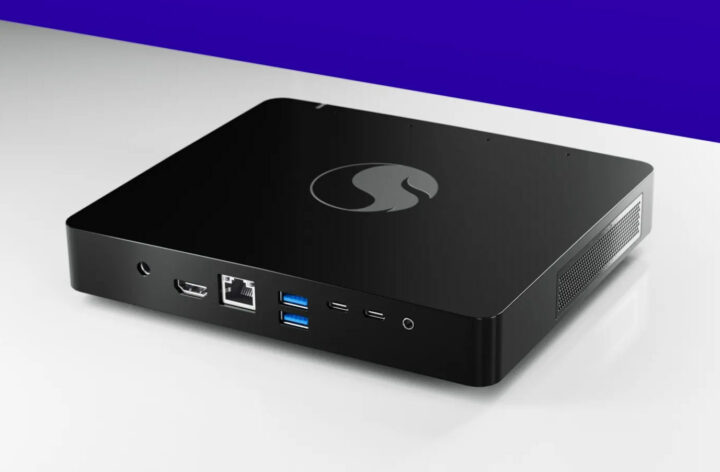Qualcomm Snapdragon Dev Kit for Windows is a mini PC-looking development platform based on the Snapdragon X Elite 12-core Arm processor with up to 75 AI TOPS of performance designed to help developers natively port apps to the Elite X SoC and develop new AI applications besides the Copilot+ AI PC features developed internally by Microsoft.
Although it’s slightly bigger, the external design looks similar to the Windows Dev Kit 2023 with a Qualcomm Snapdragon 8cx Gen 3 compute platform, but internally, the new devkit features the much more powerful 4.3 GHz X Elite 12-core 64-bit Armv8 Oryon processor coupled with 32GB LPDDR5x RAM and 512GB NVMe SSD, and offering a range of ports and features such as USB4 and WiFi 7.
Snapdragon Dev Kit for Windows (2024) specifications:
- SoC – Snapdragon X Elite (X1E-00-1DE)
- CPU – 12-core 64-bit Armv8 Oryon processor clocked at up to 3.8 GHz, or 4.3 GHz for single or dual-core boost, 42MB total cache
- GPU – Adreno GPU up to 4.6 TFLOPS, DX12 API support
- AI accelerators
- Hexagon NPU with up to 45 TOPS
- Dual micro NPU on the Qualcomm Sensing Hub
- Up to 75 TOPS in total when combining CPU, GPU, NPU, and micro NPU
- Up to 30 tokens per second for 7B LLMs
- VPU – Adreno VPU
- Encode – 4K60 10-bit encode H.264, HEVC (H.265), AV1
- Decode – 4K120 10-bit decode H.264, HEVC (H.265), VP9, AV1
- Concurrency – 4K60 decode H.264, HEVC (H.265), VP9, AV1 and 2x 4K30 encode H.264, HEVC (H.265), AV1
- System Memory – 32GB LPDDR5x RAM
- Storage – 512GB NVMe SSD
- Video Output
- HDMI port
- 3x USB4 ports
- Up to 3x 4K UHD monitors supported
- Audio – 3.5mm audio jack
- Connectivity
- Ethernet RJ45 port
- WiFi 7 and Bluetooth 5.4 via Qualcomm FastConnect 7800 Mobile Connectivity System
- USB
- 3x USB4 Type-C ports
- 2x USB 3.2 Gen 2 Type-A ports
- Security – sTPM
- Misc – Power button
- Dimensions – 199 x 175 x 35 mm
- Weight – 970 grams
- Materials – Shell made with 20% recycled ocean plastic (for ESG points… like in the previous dev kit)
Since it’s designed for Windows developers, the Dev Kit obviously ships with Windows 11. However, note that Linux development is also happening for the Snapdragon X Elite SoC and a lot of the open-source software will be upstreamed. Qualcomm will ship the kit with a 180 Watts (!) AC adapter, a power cable, and a user guide.
Developers will have access to the native Arm64 toolchain with Visual Studio/VS Code, runtimes, libraries, and frameworks, and the ability to run Arm64 VMs and CI/CD infrastructure and services directly on the device to build, test, and release software. Qualcomm also highlights the 45 TOPS NPU to accelerate (generative) AI/ML workloads such as on-device LLMs (Large Language Models) and LVMs (Large Vision Models) through the Qualcomm AI Stack and Qualcomm AI Hub with 100+ pre-trained and optimized AI models for Snapdragon.
Qualcomm is taking pre-orders for the Snapdragon Dev Kit for Windows for $899 through an online form, but retail availability is expected by June 18, 2024. Additional information may be found in the press release since there’s no product page at the time of writing…
Via Liliputing

Jean-Luc started CNX Software in 2010 as a part-time endeavor, before quitting his job as a software engineering manager, and starting to write daily news, and reviews full time later in 2011.
Support CNX Software! Donate via cryptocurrencies, become a Patron on Patreon, or purchase goods on Amazon or Aliexpress







> Qualcomm will ship the kit with a 180 Watts (!) AC adapter
This may hint at laptop makers having to take tough decisions balacing performance vs. battery life. And Geekbench browser where those laptops start to appear might already show the differences in performance possible:
https://browser.geekbench.com/v6/cpu/compare/5889305?baseline=6123006
It most like because of the USB4 ports and USB PD though them. The TDP of this dev kit is also at 80 Watts, which is about 30 Watts higher than the high-end notebooks, suggesting a higher power draw being allowed by the SoC in the dev kit. Keep in mind that there are three different SoC SKUs as well. That said, Dell appears to be having some issues in your link.
> It most like because of the USB4 ports and USB PD though them.
Good point!
> The TDP of this dev kit is also at 80 Watts
Well, then curious how ‘more performant’ the box is since so far in comparison with my MacBook Air (35W PSU, 4 P- and 4 E-cores) those ‘Elite laptops’ are a bit unimpressive: https://browser.geekbench.com/v6/cpu/compare/6163152?baseline=6123006
There were early reports about Qualcomm exaggerating the performance and it appears that it might be true.
I think Apple dropping M3 to go M4 for most devices with Armv9.4 likely means they where spooked by Qualcomm performance that yeah likely true. Wattage is higher though
Huh? As if the average Apple consumer would care about this synthetic benchmark nonsense and as if the manufacturer needs to fear other hardware that powers Windows devices?
The quick M4 adoption is more likely related to TSMC’s N3B process (the M3 is on) being too expensive (bad yield rate) or whatever else.
[ reviewers speculate&talk about M5/A19 already (maybe ~1/4-1/2yr), but no M6 or A20 mentioned on prospective ‘roadmaps’ (not much about SoCs, but maybe interesting ‘ ‘ ]
‘ ]
> no M6 or A20 mentioned on prospective ‘roadmaps’
You call this rumours BS a ‘roadmap’? The last roadmap I saw from this company was last century. And that same company also has strict rules wrt corporate design and even an own font called Myriad Set. I highly doubt such an unbelievably ugly presentation / typographic nightmare as above would be possible even for ‘internal Apple use only’.
The best scores should be coming from running the Snapdragon X Elite at 80 Watts, like in this dev kit. But it’s useful to have a greater power adapter so that you can power devices connected by USB. As for Geekbench, the Inspiron 14 Plus 7441 is almost unbelievably worse in some of those MT tests. But it shouldn’t be using the same chip, it should be using the Snapdragon X Plus with 2 less cores: notebookcheck.net/Dell-Inspiron-14-and-Inspiron-14-Plus-7441-launched-with-Snapdragon-X1-Plus-SoCs.839703.0.html Dell is introducing new Inspiron laptops powered by Qualcomm’s Snapdragon X Plus SoCs, the Inspiron 14 and the Inspiron 14 Plus 7441. Leaks so… Read more »
> Inspiron 14 Plus 7441 … shouldn’t be using the same chip, it should be using the Snapdragon X Plus with 2 less cores
At least https://browser.geekbench.com/v6/cpu/5889305.gb6 lists 12 cores in two clusters of 8 and 4 cores.
Both devices has same Snapdragon X Elite – X1E80100
So it looks like one was in windows performance mode or at least on power adapter
and another one wasn’t 🙂
It is massive difference
> It is massive difference
Yes. I initially suspected that maybe something went wrong with DRAM initialization on the Dell thing but this would’ve looked differently (see the left GB6 chart there comparing RK3588 with DRAM at 528 and 2112 MHz).
Microsoft says the Dev Kit has a peak TDP of over 80 watts.
Kinda expensive, specially for my country where due to taxes, the price would be more like $1.8k or over.
I kinda wish for one as it looks pretty cool but for early adopters of windows on arm, it’s not a very atractive price.
Or maybe I am just too poor.
We are all too poor, I wondering if ram & nvme are soldered on or standard modules.
$899 with 32GB 512GB is near half the price of a similar Mac Mini
If modules would make great 2nd user PC’s that can not say about soldered on Mac Mini’s
Perhaps a pointer to what will come a little later in more affordable devices. I suspect that Intel, AMD and most of the cheap board vendors (AMLogic, Rockhip etc) will be watching very closely and with potential trepidation. When we see the likes of the Odin 2 handheld with Gen 2 Snapdragon SOC coming in at half the price of phones that already had it, it gives you some idea of what may come down the line, provided that Qualcomm don’t try and over milk the pricing. With Windows as a prospective bas OS, this will likely have greater mass… Read more »
I’m on the waiting list. I have a 2023 dev kit but it has GPU driver issues so tends to crash under GPU load. More and faster CPU cores, faster RAM, higher TDP (30W up to 80W), better drivers and Linux support are all welcome upgrades. Even if performance isn’t that good it should still make a nice small desktop.
Do you expect Linux to run straight on the new device? Because I would like to have one, but wouldn’t want to use Windows on it
Anyone know if the Ram & Nvme is soldered on Apple style or standard modules?
$899 Makes it a very competitive vs Mac Mini
LPDDR5X is commonly soldered. The 2023 dev kit had a removable M.2 2230 SSD, it felt like a Surface Pro 9 mainboard in a different form factor so used the same SSD as those.
I guess at least the most fragile wear affected NVMe can be replaced as opposed to a Mac mini.
Ram modules would of been nice to upgrade to 64gb for those playing with LLMs